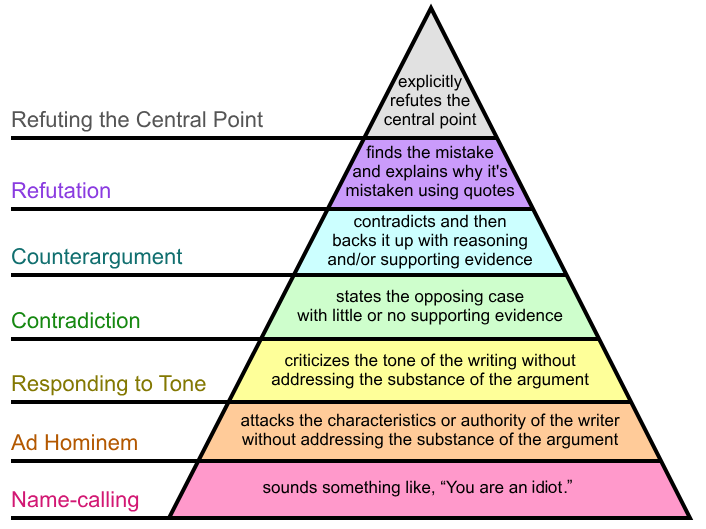간혹 회의에서 직장 상사분들이 밑도 끝도 없이 핵심 요점과 상관 없는 이유로 부하직원의 의견에 반박하는 경우를 많이 보아왔는데, 폴 그라함의 의견 불일치 계층이 이를 설명하기에 괜찮은 아이디어 같아서 가져와봤다.
의견 불일치의 계층 (Graham's hierachy of disagreement)
- 의견 불일치의 계층이 높을수록 덜 짓궂게 만들고 더 행복하게 만든다는 주장
- 높은 수준의 의견 충돌일수록 현실에서 더 귀하다.
- 가장 아랫 단계의 의견 충돌인 name-calling 은 단순한 모욕과 다르지 않다.
계층 설명
- 1단계, 욕설 (name-calling): "야이 바보야!" 같이 의견 불일치를 표현함
- 2단계, 인신공격 (ad-hominem): 논쟁의 본질보다는 화자의 특성이나 권위를 욕함
- 3단계, 어조나 분위기 공격 (responding to tone): 논쟁의 본질보다는 어조를 비난함
- 4단계, 모순 혹은 반박 (contradiction): 반박 케이스를 서술하는데 뒷받침할 증거는 없거나 매우 적음
- 5단계, 반론 (counter argument): 부정하고 적절한 추론 및 증거로 이를 뒷받침함
- 6단계, 반증 혹은 논파 (refutation): 어디에서 실수가 있는지를 발견하고 왜 이게 실수인지를 여러 인용을 통해 설명함
- 7단계, 핵심 요점 반박 (refusing the central point): 핵심 요점을 명시적으로 반박함
Graham proposed a disagreement hierarchy in a 2008 essay How to Disagree, putting types of argument into a seven-point hierarchy and observing that "If moving up the disagreement hierarchy makes people less mean, that will make most of them happier." Graham also suggested that the hierarchy can be thought of as a pyramid, as the highest forms of disagreement are rarer.
Following this hierarchy, Graham notes that articulate forms of name-calling (e.g., "The author is a self-important dilettante") are no different from crude insults.
The hierarchy of disagreement is used on English Wikipedia as a guide for constructive dispute resolution.
